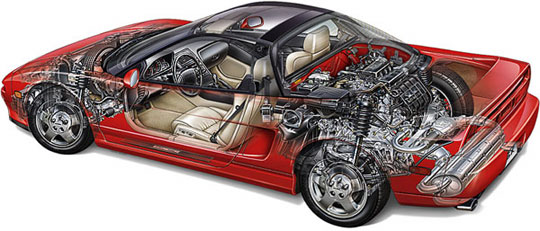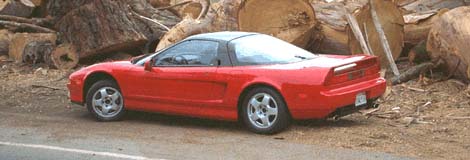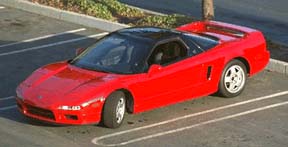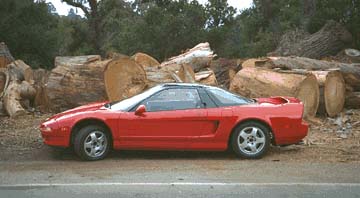Honda NSX, a nimble car, competition, engineering, modifications, my car
(various parts of this are quoted from the book you get when you buy the car)

contents
advertising:
has some quotes from a special book provided to owners of the car
competition:
I autocrossed, entered open track events, and participated in the Nevada Open Road Challenge
diagnostics:
includes a short example of a diagnostic the owner can perform.
engineering:
some quotes from the book provided with the car.
road trip:
I followed the Lewis and Clark trail, 7000 miles in two weeks.
modifications:
none really, adding harness and fire extinguisher
my car:
all about some of the things I did with my car.
open road challenge:
preparation, qualifying and entering the high speed event.
pictures:
various pictures not often found on the Internet
specifications:
specifications for the car.
(I got a nice note from Kevin Hulsey. He was the artist that did the exposed images for the NSX.)

advertising
(The Honda NSX is marketed in the United States as an Acura NSX.)
Our goal in building the Acura NSX was to produce a new-generation, limited-production, handcrafted, mid-engine exotic sports car. One that would create a new synthesis between the often contradictory targets of high performance and mechanical refinement. In short, a bona fide exotic, but one without the ergonomic and reliability penalties often associated with this type of car.
The NSX would have the performance potential of the heavyweight exotics that are generally equipped with V-8 or V-12 engines, and at the same time the quick response and agile handling of lightweight sports cars. It would also offer the comfort and interior amenities of mass-produced sports cars. But more important than this, the NSX would actually enlarge the performance envelope. Through the use of new technologies, the handling and performance limits have expanded beyond the capabilities of conventional exotic sports cars.
(chapter headings...)
We placed the engine at the rear because it was the appropriate technology, not tradition
A shape designed primarily to meet the functional needs of the driver.
When they designed the chassis, the engineering staff were absolutely rigid in their thinking.
Good aerodynamics require far more than a low drag coefficient.
A truly competent suspension should offer outstanding performance, not demand it of the driver.
When pavement conditions are less than ideal, the NSX will probably sense it before you do.
Total performance requires being prepared for the unexpected.
Proving high power and driveability are not mutually exclusive.

specifications
engine
The engine is a 3.0 liter, 24 valve, DOHC V-6 putting out 270 horsepower at 7100 rpm and 210 lbs-ft torque at 5300. It has variable intake tuning and variable valve timing with a technique called VTEC. Redline is 8000 rpm.
Qualitatively, the engine is amazing. It contributes to the broad dynamic range of the car. I can drive my daughter to the local school or enter the Nevada Open Road Challenge and the car will not complain. In the first case I am puttering around at 25 miles per hour, and the second, I am sustaining a speed of 160 miles per hour for over 15 minutes.
Exotic cars are suppose to have wonderful mechanical sounds coming from the engine. The NSX is no different but the sounds are a bit muted. On the other hand, the induction howl at high rpm, when the VTEC opens the second induction track, is inspiring.
Best of all the throttle response is immediate. The dual cam profiles contribute to good low end torque coupled with natural aspiration makes for immediate and impressive response to a press of the foot.
brakes
The NSX was one of the first production cars to provide four channel independent four wheel anti-lock brakes. There are disc brakes all around. The anti-lock mechanism is also used for the first stage traction control.
Braking distances are impressive as is control. This is partly due to the mid-engine layout, and partly due to the sticky original equipment rubber in the tires.
In practice, the anti-lock system is less than impressive. The car crabs significantly, the braking distances stretch, and the pedal feel is poor. The benefit of being able to steer in a panic situation is countered with extended stopping distance. It is easy to back slightly out of the anti lock situation and modulate the brakes to the point but into lock up.
suspension
The front suspension consists of independent aluminum double wishbone with coil springs, stabilizer bar, and compliance pivot. This latter allows both front mounts of the A arms to pivot slightly rearward in a bump situation.
Steering feel is amazing. It almost filters out the bump feedback and lets you feel the adhesion slip angle of the tires. Control here is one of the most impressive attributes of the car.
Rear suspension is similar.
The handling is one of the best features of this car. It is frequently noted by the press and is the main reason I bought this car. It is light so there is less mass to redirect. The tires are sticky, almost race tires. The suspension geometry allows all sorts of feedback to the driver, taking the handling limit of the car beyond most other cars, yet being forgiving at the limit. This car is easy to drive quickly.
The tires are Yokohama A-022 and are specially made for the car. The tire at each corner is different. They are asymmetrical and made of soft, sticky rubber, with 205-50 ZR15s in the front and 235-50 ZR16s in the rear. This is small rubber for the measured cornering forces generate by this car. The 1994 model goes plus one on the tires and wheels, this being the only change since the introduction of the car in 1991.

engineering features
The body is all aluminum, weighing 452 lbs.
The connecting rods are titanium.
The ignition system is direct, with one coil per spark plug.
There is a five speed manual transmission. The weakness of this car is the large gap between first and second, with first redlining at 40 mph. This is the ideal speed for many an autocross course, causing the engine to be off cam most of the time.
The traction control senses a difference between the relative speeds of the rear wheels and the direction the steering wheel is pointed. It will lock the wheel that is spinning too quickly causing torque to be transferred to the wheel with traction. If both rear wheels are spinning too quickly compared to the front wheels, the throttle itself is pulled back until the parameter are more like normal.
The standard type scissors jack is cast aluminum, allowing the weight of the car to be below 3010. Distribution is 42/58 and drag coefficient is .32.
Here is an example of the on board diagnostics available on the car. I strongly recommen d buying the manual as it contains all sorts of wonderful details about the car.

miscellaneous and additional links
I have many original sales brochures and Japanese publications about the NSX and have provided some of the nicer pictures here. I also have a CD ROM Press release kit. The press kit included a multimedia CD about the design and engineering of the NSX. It also allowed you to create your own advertisment by selecting the images, music and movie clips. There was even a humorous piece where aliens examined the car and participated in a round table discussion with the original designers.
Thanks to Lynne, Dan, Bryan, David, and Gary for information and support

